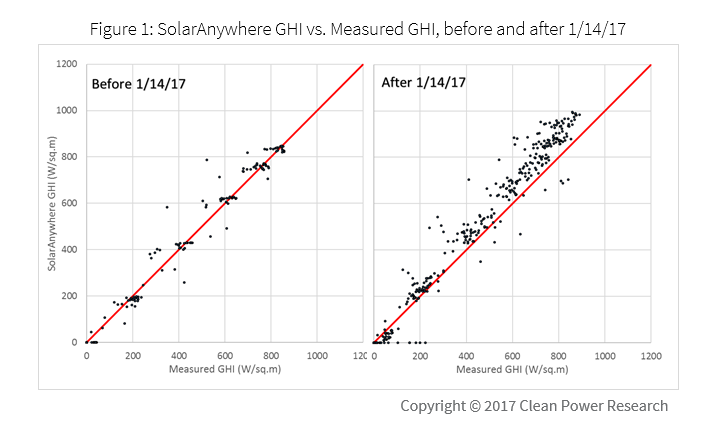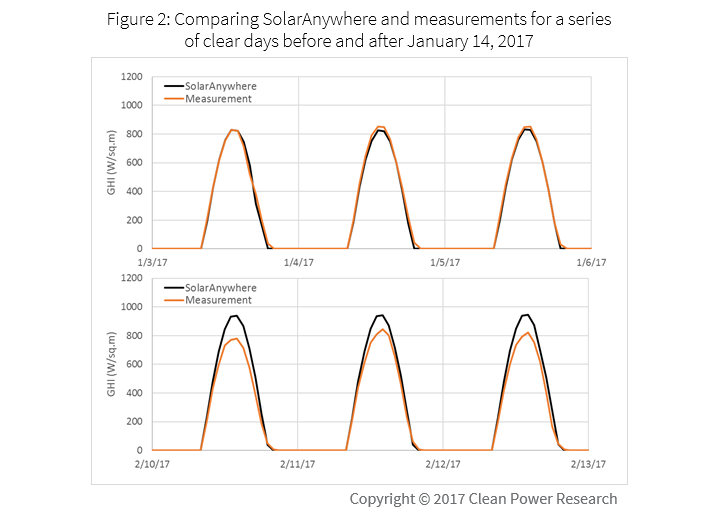Troubleshooting ground measurements with satellite irradiance data
We recently reported how the use of SolarAnywhere® Data made it possible for us to detect an unreported irradiance sensor calibration issue at one of the nation’s most trusted reference stations: the SURFRAD station of Fort Peck, Montana. We also reported in a recent article that the mean year-to-year difference over an 18-year period between SolarAnywhere and this SURFRAD station’s GHI measurements was of the order of 2%.
This difference is almost identical to the mean difference observed between two co-located measurements of GHI at that station: a direct GHI measurement with a pyranometer, and an indirect measurement obtained by addition of measured DNI and diffuse. This allowed us to state that, for this location, SolarAnywhere is as good a measure of long-term solar resource and year-to-year variability as measurements with top-of-the-line instrumentation and maintenance.
This article focuses on another example in which satellite-derived SolarAnywhere irradiance data was used to pinpoint measurement problems. A Clean Power Research customer for a project in Mexico had noted that SolarAnywhere GHI exhibited a large positive bias (10 %+) when compared to ground measurements. The customer indicated that after an initial agreement between SolarAnywhere and measurements in early 2017, the model started to significantly overestimate.
To aid us in our investigation of the discrepancy, we received hourly GHI data obtained from ground observations from January 1 through March 1, 2017. A comparison of that data against SolarAnywhere is shown in Figure 1.

The left side of the figure shows data before January 14 while the right side shows data from January 15 onward. This figure shows that a strong clear sky condition bias occurred after January 14. This clear sky bias may be better visualized in Figure 2.

Figure 2 shows series of clear days before and after that date. The question is: What happened on January 14 to cause this change of relationship between the two sources of GHI? There are two obvious possibilities for the change:
- Instrumentation malfunctioned due to either soiling or calibration mismatch.
- SolarAnywhere failed to pick-up a drastic—and sudden—change in turbidity.
In the second possibility, the turbidity change would have to be dramatic to account for these observations. For instance, AOD would have to more than triple from a background value of, say, 0.2 to more than 0.7. Precipitable water would have to be multiplied by a factor 5 to cause such a change. This turbidity increase is highly improbable unless someone can document a new, very heavy source of pollution near the measurement site that came on-line on January 15.
We cannot prove with 100% certainty that the first possibility is the cause of the discrepancy (i.e., we did not acquire and calibrate the field instrument in question); however, the circumstantial evidence is overwhelmingly pointing at instrumentation malfunction. In my experience, this type of disagreement between SolarAnywhere and ground sensors is not uncommon. In the vast majority of cases, the source of error has been attributable to the ground sensor.
Is “ground-truth” valid today?
Examples such as this lead us to a discussion about how the use of ground versus satellite data is rapidly shifting. The notion that ground-collected measurement data should always be handled as “ground-truth” is certainly called into question. The thought that ground-being-truth is always the case, we know, is not valid. Instead, the discussion should shift to our realistic understanding of what the uncertainty is of the measurement, whether it’s ground- or satellite-based.
Ground data, when collected with a well-established procedure coupled with a well-documented campaign, can provide very high accuracy and low uncertainty measurement values. Assessment of ground data measurement uncertainty, however, is very site-specific and can be difficult to repeat. The highest quality campaign process cannot be assumed on all ground data everywhere. As a result, measurement uncertainty can suffer severely, as evidenced above.
Satellite-derived data, on the other hand, have a very spatially consistent approach to measuring irradiance and carry a great value in the assurance of the predicted uncertainty.
As the solar industry continues to evolve and truly become a substantial form of the world’s electricity generation asset, we need to continue to invest in models and tools that make the financing process faster and more cost effective. I look forward to seeing see what will come to be for this industry!
Clean Power Research analyzes and documents the measurement uncertainty of SolarAnywhere Data when new models are introduced. Learn more about the uncertainty for SolarAnywhere Data v3 in our whitepaper: SUNY Satellite-to-Solar Irradiance Model Improvements.



